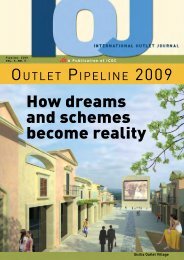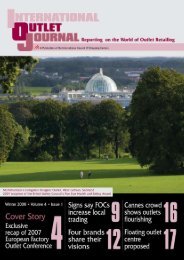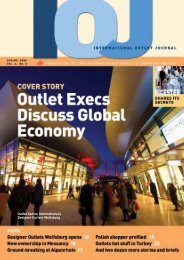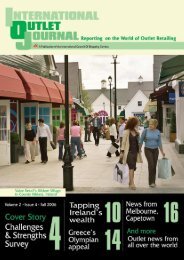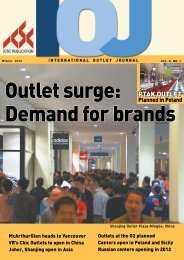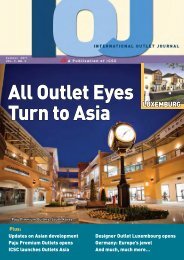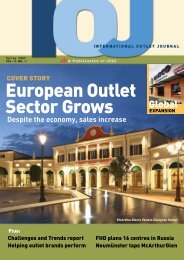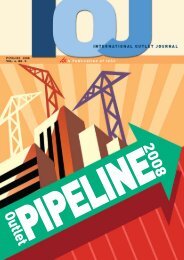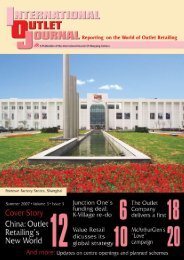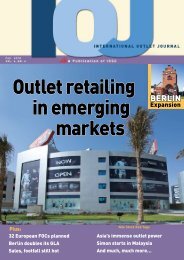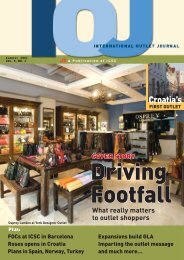For Designer Style, It's All Outlet - Value Retail News
For Designer Style, It's All Outlet - Value Retail News
For Designer Style, It's All Outlet - Value Retail News
You also want an ePaper? Increase the reach of your titles
YUMPU automatically turns print PDFs into web optimized ePapers that Google loves.
iCSC OuTlETS aSia<br />
China confronts a steep curve<br />
<strong>Outlet</strong> experts met<br />
in China to discuss<br />
the industry’s future<br />
and share information<br />
at ICSC’s two-day<br />
conference in July.<br />
By Joel McCormick<br />
iOJ Contributing writer<br />
Go smart, not fast was the message<br />
that echoed again and again<br />
at ICSC’s inaugural <strong>Outlet</strong>s Asia<br />
conference in China. The July 28-29<br />
event in Suzhou on the outskirts of<br />
Shanghai drew more than 100 developers,<br />
retailers and investors from across<br />
China, Asia, Europe and North America.<br />
Speaker after speaker in 10 educational<br />
sessions and a dozen roundtables<br />
urged industry participants in China to<br />
take the time to understand their target<br />
markets, big retail’s needs, and why letting<br />
local government determine outlet<br />
sites often leads to failure.<br />
One after another, experts cautioned<br />
against overbuilding, which appears<br />
endemic in China. Barely a handful of<br />
outlet centers in<br />
mature markets in<br />
Europe and the U.S.<br />
reach the 700,000-<br />
sf or 800,000-sf<br />
range, noted industry<br />
veteran Brad<br />
Stipe, president of<br />
Brad Stipe<br />
consultancy Stipe<br />
Property Develop-<br />
ment. “And yet when I look at projects<br />
already built in China, and projects proposed<br />
in China, I see a lot of numbers at<br />
the very top of this spectrum.”<br />
A former Chelsea executive, Stipe has<br />
worked on projects in the U.S., South<br />
Korea and Japan. “While mature markets<br />
have the majority of tenants available to<br />
them,” Stipe said, “in China many of the<br />
tenants haven’t even arrived here, much<br />
less stabilized their business to the point<br />
of taking it to the outlet side of things.”<br />
China has 23 outlet centers now and es-<br />
26 InternAtIOnAl <strong>Outlet</strong> JOurnAl Fall 2011<br />
<strong>Outlet</strong>s Asia, ICSC’s first conference exclusively for the outlet industry in China, drew<br />
more than 125 attendees when it was held in July.<br />
timates suggest 30 to 40 more will come<br />
online over the next few years. Stipe said<br />
he sensed a “build it and they will come”<br />
mentality. Little wonder: As Beijing<br />
drives efforts to expand China’s domestic<br />
economy and lessen dependence on<br />
exports, the country finds itself in the<br />
midst of an unrelenting mall boom. And<br />
that was mirrored in conference attendee<br />
numbers: Chinese delegates came from a<br />
dozen cities, many in the country’s interior<br />
– a sure sign that interest in the outlet<br />
model is spreading inland from China’s<br />
wealthy east coast centers.<br />
Citing ICSC data, keynote speaker<br />
David Ober, president of U.S. outlet company<br />
Global <strong>Outlet</strong> Management, said in<br />
his State of the <strong>Outlet</strong> Industry report<br />
that 11 outlet centers<br />
were due to open in<br />
China this year and 23<br />
more were planned<br />
for the next three<br />
years. But growth<br />
isn’t unique to China,<br />
he said. The U.S., in<br />
theory, was projected<br />
David Ober<br />
to see 47 added to its outlet inventory in<br />
the next few years, Canada 16, Europe<br />
another 40.<br />
“Nearly 50 outlet centers are at one<br />
stage of thought or reality in the combined<br />
Eastern Europe and the Mideast,”<br />
Ober said. “The expansion of outlets<br />
is cumulatively outpacing full-price retail<br />
across the globe.”<br />
What’s behind it?<br />
“Six or seven years ago, real estate<br />
focused on the outlet industry as lenders<br />
realized it was a powerful source of<br />
consumer spending,” Ober said, adding<br />
that U.S. outlets now outperform many<br />
full-price centers, generating as much<br />
as 50 percent of operating income for<br />
developers and retailers. In the case of<br />
publicly-traded REITs, outlet portfolios<br />
in some cases now deliver up to 70 percent<br />
of bottom-line profits, he said.<br />
While China has been accelerating<br />
expansion, however loosely “outlet” is<br />
defined, Ober said the U.S. has been<br />
consolidating and streamlining. Today,<br />
30 years after the first new-construction<br />
outlet center opened, the U.S. has just<br />
181 outlet centers. These productive,<br />
healthy, strongly tenanted centers average<br />
only 35,000 m2, compared to the average<br />
Chinese outlet center’s 65,000 m 2 .<br />
Eventually, he said, Chinese outlet centers<br />
will face the same pressures as fewer,<br />
more powerful brands take back their<br />
licenses and operate their own retail chains.<br />
“We have incredible consolidation,” he<br />
said, citing Phillips-Van Heusen (PVH)<br />
as an example. The apparel giant’s brands<br />
include Calvin Klein, Bass, Tommy<br />
Hilfiger and a long list of others. The<br />
industry is so brand-driven that of the<br />
47 centers proposed in the U.S. over the





